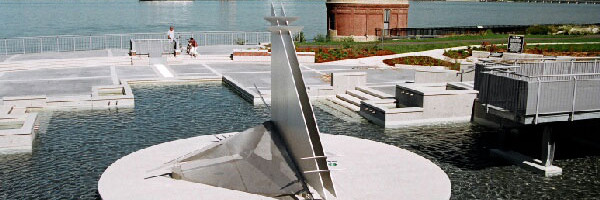Great Western Park

1388 Riverside Drive East
Great Western Park anchors the eastern end of Windsor's famous riverfront park system. It is located along the Detroit River between Aylmer Avenue and Lincoln Road. In addition to the riverfront views and pathways, visitors to Great Western Park will enjoy Bert Weeks Fountain and the Clifford and Joan Hatch Wildflower Garden.
Great Western Park gets its name from its days as a railroad connecting link.
"The main line of 'The Great Western,' from Niagara Falls through Hamilton and London to Windsor, was opened in 1854. The company extended its line from Hamilton to Toronto in 1855, from Komoka to Sarnia in 1858, and from Glencoe to Fort Erie (the 'Loop Line') in 1873. 'The Great Western' was an important connecting link for through traffic between railways in Michigan and New York states. This necessitated conversion from the original 167 cm gauge to the U.S. standard of 143 cm. The railway was one of the earliest to use sleeping and dining cars. In 1882 'The Great Western' merged with 'The Grand Trunk Railway Company' under the latter's name.” – Archaeological and Historic Sites Board of Ontario.
Bert Weeks Memorial Gardens

The Bert Weeks Memorial Gardens are named in honour of the former mayor who worked tirelessly to protect the riverfront from development. During his 40 years of public service, including eight years as mayor, Bert Weeks championed the development of nine new riverfront parks, including Ganatchio Trail, Lakeview Park Marina and Coventry Gardens.
Bert Weeks Memorial Gardens features an elaborate fountain with a reflecting pool. It links Festival Plaza Park on the west to the Joan and Clifford Hatch Wildflower Garden on the east.
Joan and Clifford Hatch Wildflower Garden

The Wildflower Garden's sculpted layout is inspired by the gentle waves and steady current of the Detroit River. The restorative landscaping with an emphasis on native plants and wildflowers was designed to be self-sustaining and also created to provide an enhanced fish habitat.
The historic 1914 Pump House is located in the Detroit River at Langlois Avenue and Riverside Drive in Windsor and was officially known as the Offshore Water Intake Building. It was originally designed by the architectural firm of Smith, Hinchman and Grylls as part of the municipal water works system in 1914. Windsor experienced a major fire in 1871 which destroyed three blocks of downtown Windsor and resulted in a new municipal water system with the later addition of the 1914 Pump house.
In 2001, the City of Windsor received a Human Resources Development Canada grant to restore the pump house as the first of five beacons to mark locations within the riverfront park system. Named the Dawn Beacon, this historic pumphouse powers the irrigation system for the park and is a location for interpretive signs explaining the heritage and environmental significance of the area.
The garden is named after Joan and Cliff Hatch, noted philanthropists. It is located in one of the historically significant areas along the Detroit River which was the original home to the Ottawa First Nation. It was abandoned by the Ottawas around 1730.
By the middle of the 18th century, the French were actively encouraging settlement in this area. By 1760, the British had taken over, and the United Empire Loyalists arrived in 1780. Locally, the area became known as the CNR lands because the Great Western Railway was bought out by the Canadian National Railway in 1923.
Highlights
- Bert Weeks cascading water fountain, the first water fountain on the eastern section of the riverfront parks
- Formal and naturalized gardens and trails
- The Noon Mark, located in the centre of the reflecting pool. The Noon Mark is designed to pay homage to Weeks, who ran a very successful watch repair and jewellery business.
- Wharf Boardwalk linked to the historical 1914 pump house

